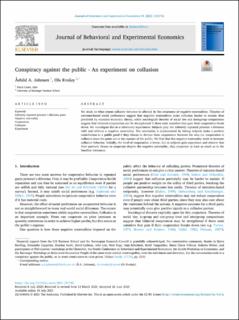| dc.contributor.author | Johnsen, Åshild A. | |
| dc.contributor.author | Kvaløy, Ola | |
| dc.date.accessioned | 2021-09-02T08:16:56Z | |
| dc.date.available | 2021-09-02T08:16:56Z | |
| dc.date.created | 2021-08-31T08:49:31Z | |
| dc.date.issued | 2021-07 | |
| dc.identifier.citation | Johnsen, Å.A., Kvaløy, O. (2021) Conspiracy against the public - An experiment on collusion. Journal of Behavioral and Experimental Economics, 94, 101742. | en_US |
| dc.identifier.issn | 2214-8043 | |
| dc.identifier.uri | https://hdl.handle.net/11250/2772419 | |
| dc.description.abstract | We study to what extent collusive behavior is affected by the awareness of negative externalities. Theories of outcome-based social preferences suggest that negative externalities make collusion harder to sustain than predicted by standard economic theory, while sociological theories of social ties and intergroup comparisons suggest that bilateral cooperation can be strengthened if there exist outsiders that gain from cooperative break down. We investigate this in a laboratory experiment. Subjects play the infinitely repeated prisoner's dilemma with and without a negative externality. The externality is implemented by letting subjects make a positive contribution to a public good if they choose to deviate from cooperation between the two, i.e. cooperation is collusive since the gains are at the expense of the public. We find that this negative externality tends to increase collusive behavior. Initially, the level of cooperation is lower, but as subjects gain experience and observe that their partners choose to cooperate despite the negative externality, they cooperate as least as much as in the baseline treatment. | en_US |
| dc.language.iso | eng | en_US |
| dc.publisher | Elsevier Ltd. | en_US |
| dc.rights | Navngivelse 4.0 Internasjonal | * |
| dc.rights.uri | http://creativecommons.org/licenses/by/4.0/deed.no | * |
| dc.subject | økonomi | en_US |
| dc.title | Conspiracy against the public - An experiment on collusion | en_US |
| dc.type | Peer reviewed | en_US |
| dc.type | Journal article | en_US |
| dc.description.version | publishedVersion | en_US |
| dc.rights.holder | © 2021 The Author(s). | en_US |
| dc.subject.nsi | VDP::Samfunnsvitenskap: 200::Økonomi: 210::Bedriftsøkonomi: 213 | en_US |
| dc.source.pagenumber | 1-11 | en_US |
| dc.source.volume | 94 | en_US |
| dc.source.journal | Journal of Behavioral and Experimental Economics | en_US |
| dc.identifier.doi | 10.1016/j.socec.2021.101742 | |
| dc.identifier.cristin | 1929926 | |
| dc.source.articlenumber | 101742 | en_US |
| cristin.ispublished | true | |
| cristin.fulltext | original | |
| cristin.qualitycode | 1 | |

